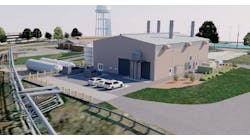A new residential neighborhood in Alabama will feature a research microgrid that aims to help Alabama Power better understand the benefits and appeal of smart systems, including microgrids and appliances that can be controlled by phones.
Smart Neighborhood, a community of 62 homes, is a partnership among the utility, developer Signature Homes, Oak Ridge National Laboratory and technology vendors. Construction is expected to begin as early as June on the project.
Signature Homes will sell the houses. Alabama Power, a unit of Southern Company, will own and operate the microgrid. Vendors will provide smart appliances, and Oak Ridge will collect data and provide microgrid management, said Sam Duncan, principal engineer for Alabama Power.
“We’re really excited about this,” he said. “We have been looking for an opportunity to showcase energy-efficient technologies and our microgrid.”
The project includes a 330-kW solar array, two batteries that provide 1,000 kW of energy storage and a 360-kW natural-gas fired generator. The microgrid will be tied to the utility and will have the ability to island from it during outages. Customers will be served by both the microgrid and the grid.
For research purposes, initially the microgrid will be connected to a load bank that won’t supply power to the homes.
A load bank, Duncan explained, is a big resister that dissipates energy in the form of heat. Hooking up solar and storage in the load bank will allow the company to test the system and ensure it doesn’t affect power quality, said Duncan.
“We usually provide large reliable power,” he said. “With inverter-driven equipment, we want to show that we can serve the customers without negatively impacting their power quality.
“This is a research project; we don’t want to affect customers negatively,” he added. When the company feels confident that the equipment will serve customers well, it will provide the energy from the microgrid to them.
The project study what services the microgrid can provide, Duncan said. “Can those batteries do more than one thing like peak shaving, or riding through cloudy periods and sustaining energy to customers? We aren’t limiting ourselves, but testing power quality improvements and balancing improvements.”
Will customers load shift?
Along with the research microgrid, the project features smart appliances—refrigerators, cooking ranges, washers, dryers and dishwashers–that can be controlled using homeowners’ phones. This part of the project will examine how willing customers are to shift their loads and whether customers see load shifting as valuable.
The company offers time-of-use rates under which Alabama Power rewards customers for plugging in loads during-off peak hours. Called Time Advantage rates, the rates aim to encourage customers to avoid peak hours, which are from 1 to 7 pm during the summer.
Customers can shift energy use to “economy pricing periods,” between 7 pm and 1 pm, when prices are about 5.5. cents per kWh. If they use energy during peak periods, the price is 25.5 cents/kWh, according to the company’s website.
The company would like customers—and the microgrid—to shift all peak loads to off-peak, Duncan said. “Ideally, you’d want the entire load shape to be flat. Because our appliances turn on and off, we look at how that can create a flatter load shape.”
[clickToTweet tweet=”#Microgrid in Alabama Neighborhood an IQ Test for Smart Systems” quote=”Microgrid in Alabama Neighborhood an IQ Test for Smart Systems”]
The various partners will contribute to the cost. Alabama Power has already received a nod from state regulators to proceed with the project. Ratepayers would pay for Alabama Power’s share of the project.
“All customers will benefit from the microgrid components,” Duncan said. Parts of the project will save energy, and some will generate energy, he added. “Also there will be environmental benefits to the people in the area.”
The project will collect energy usage and performance data from the homes’ cutting-edge features, and analyze how these features—such as the smart appliances—can improve how homes are built and help homeowners. Alabama Power says it will use information from the HVAC systems, heat pump water heaters and other technologies to provide new, creative energy solutions for its customers.
Track news about Alabama Power’s research microgrid. Subscribe to the free Microgrid Knowledge newsletter.







